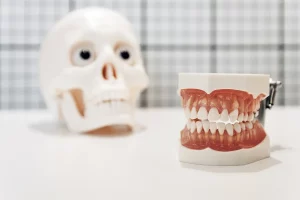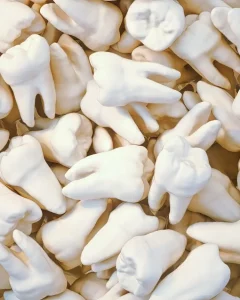Last Updated on: 13th August 2025, 09:21 am
Teeth are essential for eating, speaking, and smiling—and they’re a key part of your overall health. At Channel Islands Family Dental in Ventura, CA, we often get questions like: How many teeth do adults have? How is a tooth made? Why are teeth lost? In this article, we break it all down in simple terms with local expertise.
What Ventura Patients Should Know About the Function of Teeth
Teeth grind food to help with digestion supporting your nutrition and health. But that’s not all: they also play a crucial role in vocalization and speech. At our Ventura clinic, we see every day how the right dental care improves not just chewing but communication.
What Is a Tooth Made Of and How Is It Structured?
Each tooth is made of four layers:
- Enamel
It is the outer white part that protects the inner layers from injury or decay. It is the hardest tissue in the body and develops in three phases:
- In the first stage are the ameloblasts – a type of cell found only in teeth – that produce proteins and enamel crystals.
- In the second or transition period, approximately 25% of the ameloblasts die and the production of enamel proteins decreases.
- In the last phase or maturation, enamel crystals grow, hardening it and rendering it durable.
Dentin
This is the intermediate layer, a fundamental part of dental tissues that constitutes a large part of the dental structure. It is similar to bone and connects to the pulp, but it does not have blood vessels.
The Cement
It covers the root surfaces whose function is to adhere the teeth to the jaws. In 2016, the Japanese Journal of Dental Science noted that in single-rooted teeth, non-cellular fiber cementum covers 60-90% of teeth and 33-50% of multi-rooted teeth.
The Pulp
This is the innermost layer and the living core of the tooth. It is made up of blood vessels, connective tissues, and nerves.
The crown is located at the top of the tooth at the gum line; the part that is covered by the gums is the root, which connects the tooth with the jaw.
If any bacteria cross the enamel and dentin, the pulp becomes inflamed in an antibacterial reaction to protect the tooth. This can cause pulpitis, which can be quite painful.
The Primary Teeth
The beginning of the primary teeth also called the milk teeth, occurs at around six months of age. By the age of two or three, a child should have a complete set of primary or temporary teeth.
The traditional set of primary teeth is made up of 20 pieces: 10 in the upper part and 10 in the lower jaw. They have thinner layers of enamel and dentin than permanent teeth.
The primary teeth mark the position of most of the permanent teeth in the jaw, which is why maintaining the good oral health of milk teeth will induce good oral health in adulthood. Childhood dental caries can have adverse effects on permanent teeth.
It is suggested to brush the primary teeth for two minutes, just as it is done with the permanent teeth.
When are Milk Teeth Lost?
The change in the game of teeth begins at the age of five when the milk teeth are shed and the permanent ones emerge, ending around the age of 20 when the wisdom teeth erupt in the back of the gums
How Many Teeth Do Adults Have?
The set of adult teeth is made up of 16 teeth in the lower jaw and the same number in the upper jaw, for a total of 32.
The set of permanent teeth includes four types, each with its own function:
- 8 incisor teeth are the front ones. Four are at the top and the others are at the bottom. These teeth hold and cut food. In addition, they help feel the texture and type of food.
- 4 canine teeth are located next to the incisors. They are known as fangs and are characterized by having a cusp that helps press and tear food. They also prevent a clash between the upper and lower teeth.
- 8 premolars. They are behind the canines and are the largest teeth. There are four in the upper gum and another four in the lower gum, two on each side. They have two cusps that help cut and tear food.
- 12 molars. They have wide chewing surfaces to grind food. They include wisdom teeth, which can appear as early as 20 years old and are often extracted.
Some people do not have enough space for all 32 teeth, which is why wisdom teeth often need to be removed. This change in the space of the oral cavity could be the consequence of the variation in the food diet during the process of evolution of humanity from nomadic hunters to sedentary farmers. Softer, easier-to-chew foods did not require a large jaw.
Why the Difference in the Number of Teeth Between the Two Dental Sets?
The set of primary or milk teeth is 20 pieces because the mouth does not have enough room for a complete set of permanent teeth.
At birth, the jaw genetically has two sets of teeth, that is, 52 dental pieces: 20 milk teeth and 32 permanent ones. Additional space is acquired with growth and development.
Differences Between Primary and Permanent Teeth
- The permanent ones are larger than the temporary ones. In fact, the dental tissue is thicker.
- Primary dentition does not include premolars. The pulp chamber is larger than in a permanent tooth.
- The set of permanent teeth has no gaps. Milk teeth show a separation.
What Causes Adults to Lose Their Teeth?
The Center for Disease Control and Prevention (CDC) points out that 26 percent of adults over the age of 65 have eight fewer teeth, while 17% have lost all their teeth. eight fewer teeth affect the intake of meat, fruits, and vegetables, which over time can cause malnutrition in the elderly.
Periodontal disease or caries is the most frequent cause of tooth loss. Age, lifestyle, and one’s education level also affect people’s oral health habits.
Of note, the State Department of Health and Human Services specifies that teeth are often lost due to orthodontics or extraction.
Risks of Having Too Many Teeth
- Misalignment.
- Increased decomposition.
- Impact on the wisdom teeth, which is why they are often extracted.
- Risk of periodontal disease.
How Can I Take Care of My Teeth in Ventura?
Oral hygiene habits are essential for good oral health. It is suggested:
- Use toothpaste with fluoride.
- Brush your teeth at least twice a day
- Use dental floss.
- Limit consumption of sugary foods and drinks
- Stop smoking or reduce the frequency of tobacco use.
- Visit the dentist at least once a year.
By following these recommendations, you will be able to minimize any oral health problem that may present as you attend to it in a timely manner.
Contact us
If you have any questions about How many teeth do adults have? or other topics, you can contact us at Channel Islands Family Dental as well as our page on Facebook. We look forward to your visit and we will make a timely diagnosis. Our dentists in Oxnard, Santa Paula, Ventura, Newbury Park, and Port Hueneme will be able to guide you toward the best treatment to take care of your health and give you back your best smile.
Bibliography
- Norris, Taylor (2019). How Many Teeth Should I Have? https://www.healthline.com/health/how-many-teeth-do-adults-have
- Page, Chloe (2022) How many Teeth do humans have? https://www.livescience.com/how-many-teeth-do-humans-have
- Sulyanto Rosalyn (2021). Biology of teeth / MSD Manual. https://www.msdmanuals.com/es-co/hogar/oral-and-dental-disorders/biolog%C3%ADa-de-la-boca-y-de-los-dientes/biolog%C3%ADa- of-the-teeth
Zambon, Veronica (2020). How many teeth should a person have? https://www.medicalnewstoday.com/articles/how-many-teeth-do-adults-have
















